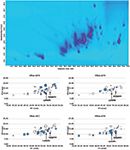Determination of Phenolic Compounds in Virgin Olive Oil Using Comprehensive 2D-LC
This application note demonstrates how comprehensive 2D-LC can be used to resolve the complex mixture of hydrophilic phenols found in virgin olive oil and investigates differences in the phenol composition of several olive oils.
This application note demonstrates how comprehensive 2D-LC can be used to resolve the complex mixture of hydrophilic phenols found in virgin olive oil and investigates differences in the phenol composition of several olive oils.
Virgin olive oil is associated with the health and nutritional benefits of the Mediterranean diet. In this respect, the presence of antioxidants, which are represented by hydrophilic phenols among others, plays an important role. Hydrophilic phenols contained in virgin olive oil include phenolic acids and alcohols, flavonoids, secoiridoids, and lignans (1,2).
One-dimensional liquid chromatography is not able to resolve completely the complex mixture of hydrophilic phenols present in virgin olive oil (3). Due to its high separation capability, comprehensive 2D-LC can be deployed to improve the separation.
Experimental Conditions
Comprehensive 2D-LC analysis was achieved with the Agilent 1290 Infinity 2D-LC solution. The first dimension separation used an Agilent ZORBAX RRHD Eclipse Plus Phenyl-Hexyl column (2.1 × 150 mm, 1.8 µm) with a gradient of water and methanol, each with 0.1% formic acid, at a flow rate of 0.05 mL/min. In the second dimension, an Agilent ZORBAX RRHD Eclipse Plus C18 column (3.0 × 50 mm, 1.8 µm) was used with shifted gradients of water and acetonitrile, each with 0.1% formic acid, at a flow rate of 3.0 mL/min. Modulation was realized using the Agilent 2-position/4-port duo-valve, equipped with two 60 µL loops and with a modulation time of 30 s. Detection was performed at 260 nm and by ESI-TOF-MS in negative ionization mode. Preparation of olive oil samples was carried out according to the protocol from the International Olive Council (4).
Results
Four different olive oil samples with high phenol content (3) purchased from Italian olive oil farms were analyzed by comprehensive 2D-LC. Figure 1 (top) exemplarily shows the 2D-LC chromatogram of one olive oil.
MS detection showed that the main hydrophilic phenols present in the analyzed olive oils are aglycons of oleuropein, ligstroside, and their derivatives. Further, elenolic acid, luteolin, apigenin, hydroxytyrosol, and hydroxytyrosol acetate were identified in all olive oils analyzed. Compared to the olive oils A–C (from the same farm), olive oil D (from another farm) showed higher percent responses of the flavonoids apigenin and luteolin (Figure 1).

Figure 1: Two-dimensional-LC chromatogram of an olive oil at 260 nm (top) and visualization of differences between the olive oils analyzed (bottom); blue circles indicate higher percent responses and white circles lower percent responses of substances detected, areas indicate differences.
Conclusions
The Agilent 1290 Infinity 2D-LC solution can be used to improve significantly the separation of hydrophilic phenols contained in virgin olive oil. This enables the investigation of differences between the compositions of hydrophilic phenols in olive oils.
References
(1) M. El Riachy et al., Eur. J. Lipid Sci. Technol. 113, 678–691 (2011).
(2) Y. Ouni et al., Food Chemistry, 127, 1263–1267 (2011).
(3) S. Schneider, "Quality Analysis of Virgin Olive Oils – Part 6," Agilent Application Note, publication number 5991-3801EN, (2014).
(4) "Determination of biophenols in olive oils by HPLC," International Olive Council: COI/T.20/DOC. 29, (2009).

Agilent Technologies Inc.
5301 Stevens Creek Blvd., Santa Clara, CA 95051
Website: www.agilent.com

Analytical Challenges in Measuring Migration from Food Contact Materials
November 2nd 2015Food contact materials contain low molecular weight additives and processing aids which can migrate into foods leading to trace levels of contamination. Food safety is ensured through regulations, comprising compositional controls and migration limits, which present a significant analytical challenge to the food industry to ensure compliance and demonstrate due diligence. Of the various analytical approaches, LC-MS/MS has proved to be an essential tool in monitoring migration of target compounds into foods, and more sophisticated approaches such as LC-high resolution MS (Orbitrap) are being increasingly used for untargeted analysis to monitor non-intentionally added substances. This podcast will provide an overview to this area, illustrated with various applications showing current approaches being employed.


















